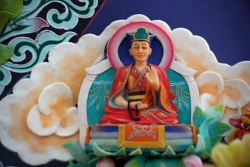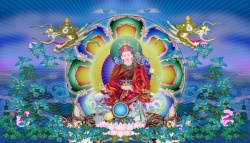Manual of Prajna Paramita - Reading One: The Three Kinds of Refuge
From the presentation on The Three Refuges found in the Analysis of the Perfection of Wisdom, by Kedrup Tenpa Dargye (1493-1568):
Here we will discuss the line of the root text which says, “The Three Jewels, the Buddha and the rest.” Let us first consider the section of the middle-length sutra on the Mother which includes the lines:
Do not think that this very Knowledge of All Things is something which applies to what you can see, and do not think it is separate from what you can see. Just so, never view what you can see itself as being real.
These are the “Instruction on the Three Jewels,” for they are words from the middle-length sutra on the Mother which give us the following advice:
These Three Jewels are no place of refuge for persons who seek an ultimate liberation. They are a place of refuge for persons who seek a liberation only in words.
Our analysis of this section will proceed in three parts: a refutation of our opponent’s position, a presentation of our own position, and a rebuttal of their objections.
Here is the second section, in which we present our own position. There is a specific reason why the Three Jewels are established as being the refuges for practitioners of the three classes. From the point of view of cause refuge, practitioners of all three classes take refuge in all three of the Jewels. But from the point of view of result refuge, those of the Listener class aspire chiefly to attain the state of a foe destroyer.
Those of the class of Self-Made Buddhas aspire chiefly to attain that meditative wisdom where they abide in a meditation of cessation, a state where all the obstacles of the mental afflictions have been eliminated.
Those of the Greater Way aspire chiefly to attain the Buddha Jewel, one who possesses that cause within him which will allow him to turn the wheel of the dharma, in its entirety, for disciples of all three classes. This then is the reason why the Three Jewels are established as being refuges for practitioners of the three classes.
The definition of the Buddha Jewel is “That ultimate place of refuge, the one which has completely satisfied both the needs.” There are two kinds of Buddha Jewel: the apparent Buddha Jewel, and the ultimate Buddha Jewel.
This Buddha Jewel posseses eight different fine qualities, beginning with the quality of being uncaused. As the Higher Line states,
This is the One, the Buddha:
He is uncaused, He is spontaneous,
He is realized by no other way;
He has knowledge, and love, and power;
He has satisfied both the needs.
The definition of the Dharma Jewel is “The enlightened side of truth, either in the form of a cessation, or in the form of a path, or both.” In name only this Jewel can be divided into two kinds: the ultimate Dharma Jewel, and the apparent Dharma Jewel.
The definition of the Sangha Jewel is “A realized being who possesses any number of the eight fine qualities of knowledge and liberation.” In name only, this Jewel can be divided into two kinds: the ultimate Sangha Jewel, and the apparent Sangha Jewel.
The definition of an ultimate refuge is “Any refuge where the journey along the path has reached its final goal.”
The definition of an apparent refuge is “Any refuge where the journey along the path has not reached its final goal.”
The definition of taking refuge is “Any movement of the mind that acts of its own accord, and consists of hoping that some object outside of one’s self will be able to render one assistance.”
In name only, taking refuge may be divided into two: taking refuge in words, the expression of refuge; and taking refuge in thoughts, the reliance on refuge. An example of the first would be something like the words you use as you take refuge.
The latter is of two types: ordinary taking of refuge, and exceptional taking of refuge. The definition of the first is “Any movement of the mind which acts of its own accord, and consists of hoping that some ordinary type of refuge will render one assistance.”
The definition of the latter is “Any movement of the mind which acts of its own accord, and consists of hoping that any one or number of the Three Jewels will render one assistance.”
There are five different kinds of this extraordinary taking of refuge: the taking of refuge which is shared with practitioners of a lesser scope, the taking of refuge which is shared with practitioners of a medium scope, the taking of refuge which is shared with practitioners of a greater scope, cause refuge, and result refuge.
Here are their respective definitions. The first is defined as: “First, you feel a personal fear for the sufferings of the births of misery. Second, you believe that the Three Jewels possess the power to protect you from these sufferings. Finally you have a thought which acts of its own accord: it is a hope, or something of the type, that some one or number of the Three Jewels will render you assistance, to protect you from these sufferings.
The second is defined as: “First, you feel a personal fear for each and every suffering of the cycle of life. Second, you believe that the Three Jewels possess the power to protect you from these sufferings. Finally you have a movement of the mind which acts of its own accord: it is a hope, or something of the type, that some one or number of the Three Jewels will render you assistance, to protect you from these sufferings.
The third is defined as: “Any movement of the mind which acts of its own accord, and consists of hoping that any one or number of the Three Jewels will render assistance, to protect every living being from the sufferings of the cycle of life.”
The fourth is defined as: “Any movement of the mind which acts of its own accord, and consists of hoping that any one or number of the Three Jewels, as already achieved in another person, will render assistance.” The fifth is defined as: “Any movement of the mind which acts of its own accord, and consists of hoping that any one or number of the Three Jewels, as they are to be achieved within ones self, will render assistance.”
There is a specific purpose for taking refuge in the Three Jewels. A temporal purpose is that they can provide you the highest form of protection. The ultimate purpose is to attain the state of enlightenment.
Taking refuge also serves as the foundation for all the different kinds of vows. When you take refuge, you thereby join the ranks of the “ones inside”: you become a Buddhist. This taking refuge acts as well to slam shut the door to the births of misery. These and others are the purpose for taking refuge in the Three.
See also
- Manual of Prajna Paramita - Reading One: The Three Kinds of Refuge
- Manual of Prajna Paramita - Reading Two: The Wish for Enlightenment
- Manual of Prajna Paramita - Reading Three: What is Nirvana?
- Manual of Prajna Paramita - Reading Four: The Object We Deny
- Manual of Prajna Paramita - Reading Five: The Proofs for Emptiness
- Manual of Prajna Paramita - Reading Six: Who is Maitreya?
- Manual of Prajna Paramita - CLASS NOTES





